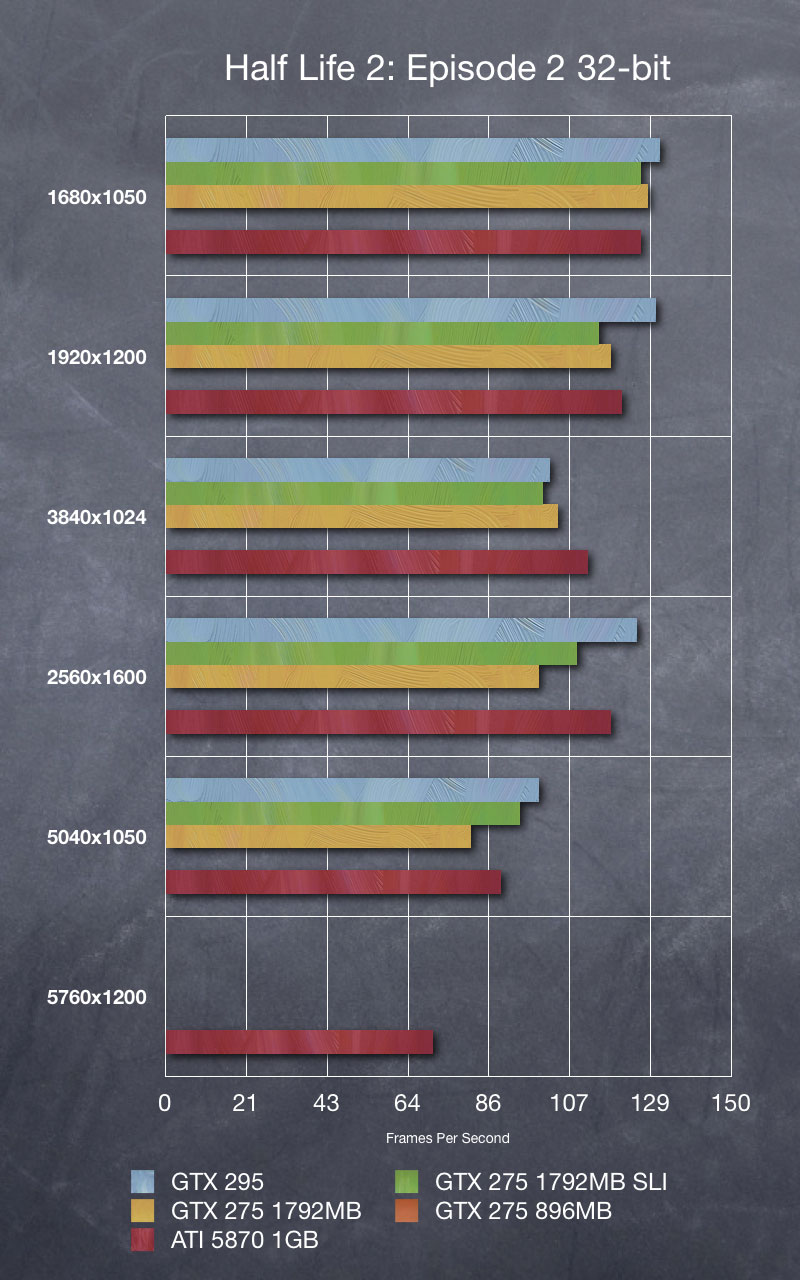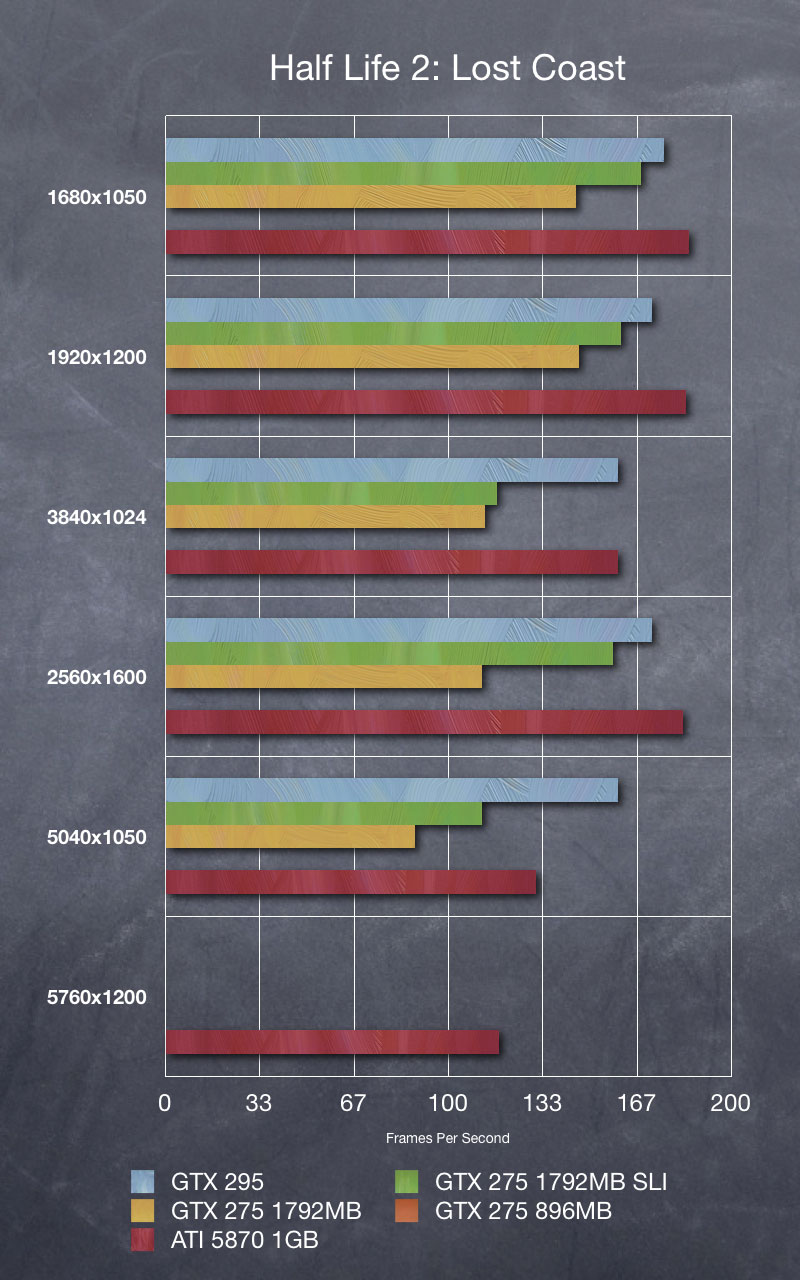Initial ATI Radeon HD 5870 1GB Benchmarks
This article brings us our first benchmarks of an ATI card, and our first experience with EyeFinity. I was fortunate enough for ATI to contact the WSGF, and I was able to obtain an HD 5870 1GB sample for testing. A full review will follow, but I wanted to get the numbers out as soon as I could.
My rig currently stands at:
- ATI Radeon HD 5870 1GB Catalyst 9.10
- EVGA X58 Tri-SLI Motherboard
- Intel i7 920 at 4x2.67GHz
- 12GB G.Skill DDR3 RAM
- 2x Samsung 320GB T-Series HDD (one for the OS and games; one for swap file and FRAPS)
- LG Super Multi Blu (HD-DVD/Blu-Ray Player)
- Onboard audio
- Corsair HX1000
- Antec Skeleton
- Logitch K340 Keyboard & Performance MX Mouse
- 3x Dell U2410
For the EyeFinity testing I've made a few changes to the rig. First I've swapped the three Dell SP2208WFP panels for three Dell U2410 panels. This means moving up to 24" and 1920x1200. I have also dropped the 30" 3007WFP from my workstation as a whole. I have simply run out of desk room. I ran it primarily on my Mac Pro, but now have the Mac hooked up to two of the Dell U2410 panels. I actually get more resolution and real estate, and having multiple screens there is better as well. I also swapped out the huge "gamer" G15 keyboard for something smaller and wireless. Same with the mouse.
In the first parts of the series, we looked at the difference between the 896MB and 1792MB versions of the GTX 275, and then the GTX 275 1792MB in SLI. This was all done in comparison to our original benchmarking of the dual-GPU GTX295.
We found that in general the 1792MB version didn't provide a noticeable difference when comparing "average framerates," but it did provide a noticeably smoother experience (over the 896MB version) (fewer "hiccups") in demanding games such as Far Cry 2. This was particularly noticeable in Wide Surround - 5040x1050.
I expect to have the same findings as we go through the ATI cards - 2GB (and possibly greater cards) will show a benefit at the higher EyeFinity Resolutions. This would be particularly true at 3x1920x1200, which is pushing 6.9M pixels. That is a lot of geometry, and a lot of textures. I dare say that a 4GB card would should performance gains, especially at 4x or 8xAA.
Half-Life 2: Episode 2 & Lost Coast
Based on our previous findings on issues around the 64-bit executables in HL2, we continue to use the 32-bit code.
In the Episode 2 benchmark, the Radeon 5870 holds even with basically every NV card combination we have tested, pulling ahead in the 3840x1024 multi-mon configuration. We would expect the same at 5040x1050 and 5760x1200, however we are unable to do a comparison. The ATI drivers don't support the "non-native" 5040x1050 on the 24" panel (though they do on native panels), and the TripleHead2Go (used for the NV testing) doesn't support 5760x1200. THe Radeon is pushing 60+ fps at 5760x1200 at max settings.
For Half-Life 2: Lost Coast the 5870 consistently beats every NV card combination - even the dual-GPU GTX295, and the GTX275 1792MB in SLI (with more GPUs and more memory). The Radeon HD 5870 1GB matches the 5040x1050 performance of the GTX 295 - while running at 5760x1200. The difference between 5.3M and 6.9M pixels is 30.6% or 1.6M pixels. HL2:LC isn't the most demanding of games, but the huge increase in performance is impressive
However, the single 5870 is basically overkill at all but 5760x1200, but that where most of us would play. ;-). Otherwise you will see performance in the 100+ fps range, and the game is basically CPU locked. Also, at the 100+fps instances, the card does not emit the horrid whine of the NV GTX200 series.


